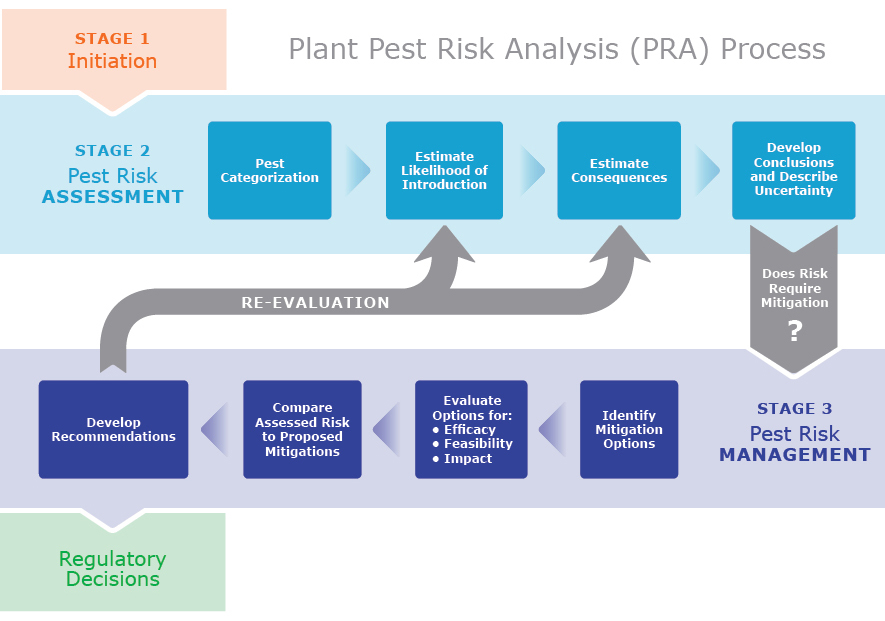Lesson 2: Pest Risk Analysis
Topic 1: What is Pest Risk Analysis?
This topic will help you remember that pest risk analysis (PRA) is the foundation of all phytosanitary regulatory decisions and activities.
Objectives:
- Describe the purpose of conducting PRA.
As mentioned in Lesson 1, one of the major functions of pest risk analysis (PRA) is to provide technical justification, or scientific basis, for plant health measures. The results from PRA are utilized by plant health officials to support all phytosanitary decisions. Pest risk analysis is also the basis for requiring measures where there is no appropriate international standard to protect national agriculture.
The IPPC (ISPM 5) defines pest risk analysis as:
“the process of evaluating biological or other scientific and economic evidence to determine whether an organism is a pest, whether it should be regulated, and the strength of any phytosanitary measures taken against it.” —ISPM 5
In practice, a PRA is the systematic process of gathering scientific evidence on biological threats, interpreting the evidence to identify the level of risk posed, and then making expert judgment calls about the measures needed to decrease the identified risks.
The standards and basic processes for conducting a PRA are outlined in ISPMs 2, 11, 14, and 21. A summary of these topics can be found in the list below.
- ISPM No. 2—Framework for pest risk analysis
- ISPM No. 11—Guidelines for pest risk analysis for quarantine pests, including analysis of environmental risks and living modified organisms
- ISPM No. 14—The use of integrated measures in a systems approach for pest risk management
- ISPM No. 21—Pest risk analysis for regulated nonquarantine pests
Here also is a graphic representation from Module 5: Pest Risk Assessment and Module 6: Pest Risk Management of the three stages and associated processes for conducting PRA.

In Stage 1, an initiating event, such as a request for market access, or discovery of a new pest may suggest the need for a new PRA or revision of an existing PRA. The goal at this stage is to determine whether or not a PRA is necessary.
In Stage 2, pest risk assessment is done through deliberative and systematic analysis including determining that the organism is actually a pest, the likelihood of its introduction, and the consequences of its introduction. In short, the goal is to assess the risk associated with the pest(s) of concern and determine which pests are dangerous enough to justify and require risk management measures.
In Stage 3, pest risk management, the assessed pest risks are used to identify mitigations that will decrease the pest risks assessed in Stage 2. This includes reviewing mitigations that are already practiced and determining if they are adequate for the assessed pest risks. The ultimate goal of this stage is to identify, evaluate, and recommend pest risk management options. Implementation of mitigations recommended by the analysis are carried out later.
Once it is decided to begin a PRA, it is critical to define the scope of what will be assessed and analyzed. If the scope is unclear, the analysis may not provide enough current and correct information to answer decision makers’ pest risk questions. The most important step in defining the scope is to define the purpose of the PRA. Is the PRA needed to evaluate a market access request? Is the PRA needed to determine the riskiest pathways (air, land, sea) for a particular organism? Is the PRA needed to determine if a particular organism should be regulated? The answer to these questions will lead the analyst to focus the risk assessment in the most appropriate way, i.e., on the organism, on the pathway, or on the commodity.
An organism PRA would gather and analyze data for just the risks involved with a specific organism. For example, an organism PRA might be done for a Bactocera fruit fly that is not yet present in a country to determine the likelihood and consequences of its introduction, and whether or not the pest should be regulated.
A commodity PRA, on the other hand, might be useful in making market access decisions. It would assess the risk from all pests associated with a specific commodity. For example, there are several pests associated with citrus such as citrus canker, thrips, red mites, and sooty mold. The risk from all of these pests would need to be evaluated before appropriate mitigations and market access decisions for citrus can be made.
A pathway PRA might be undertaken if decision-makers want to understand the highest risk pathways. Knowing the highest risk pathway would help officials decide where to station their plant health inspectors, e.g., at airports, seaports, or land border ports.
After the PRA is completed, the results of all stages in the PRA need to be summarized in a report, which will become a resource for explaining and enforcing agricultural trade requirements.
Always remember that the conclusions of a PRA must be clearly linked to the systematic assessment of scientific, economic, and other evidence. The PRA must also be transparent; that is, it must document traceable information sources, explain its methodologies, and describe its assumptions and uncertainties. A correctly executed PRA is a necessary foundation for any NPPO’s phytosanitary program.
To continue, select Topic 2 from the Topics menu above or click here.